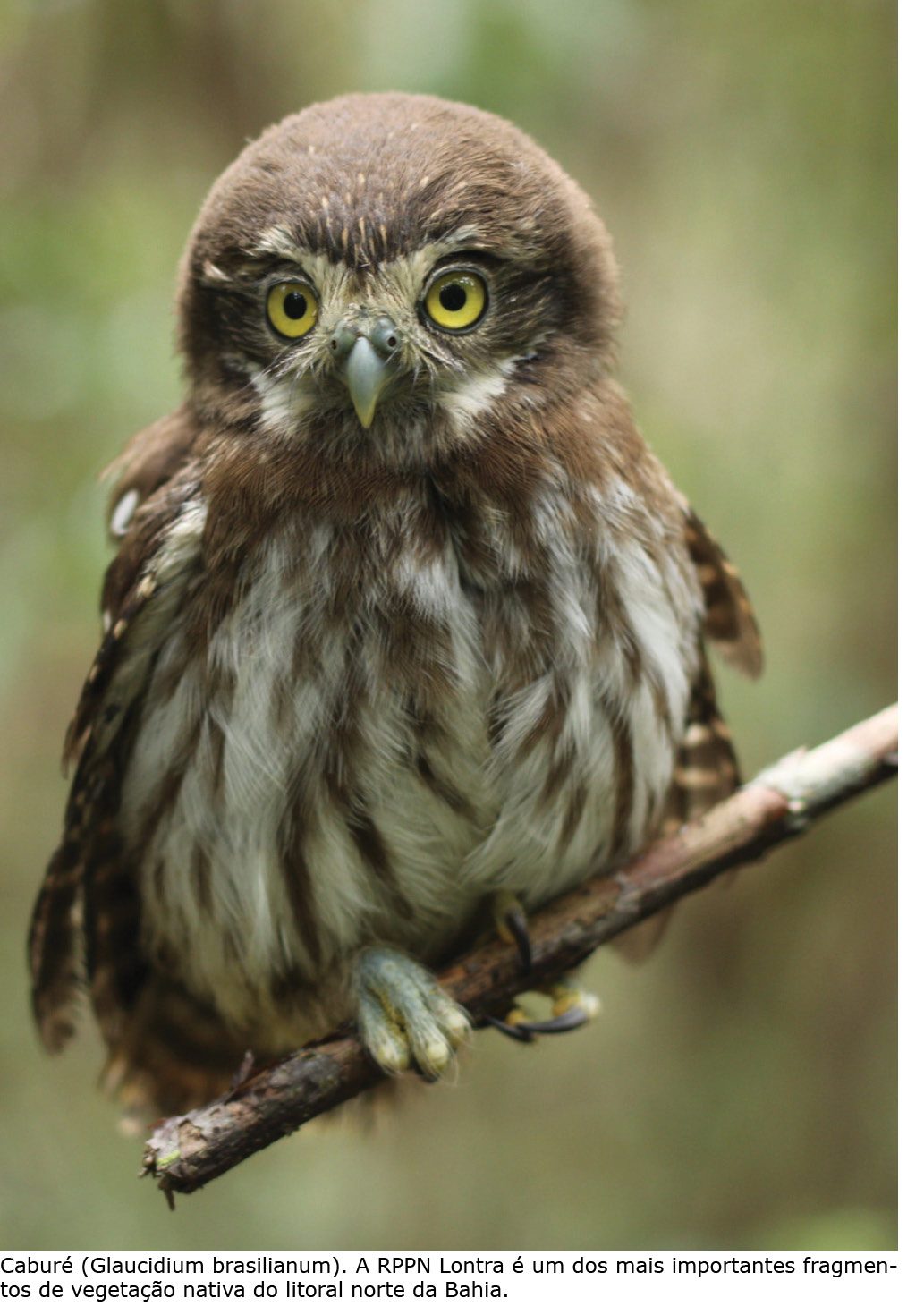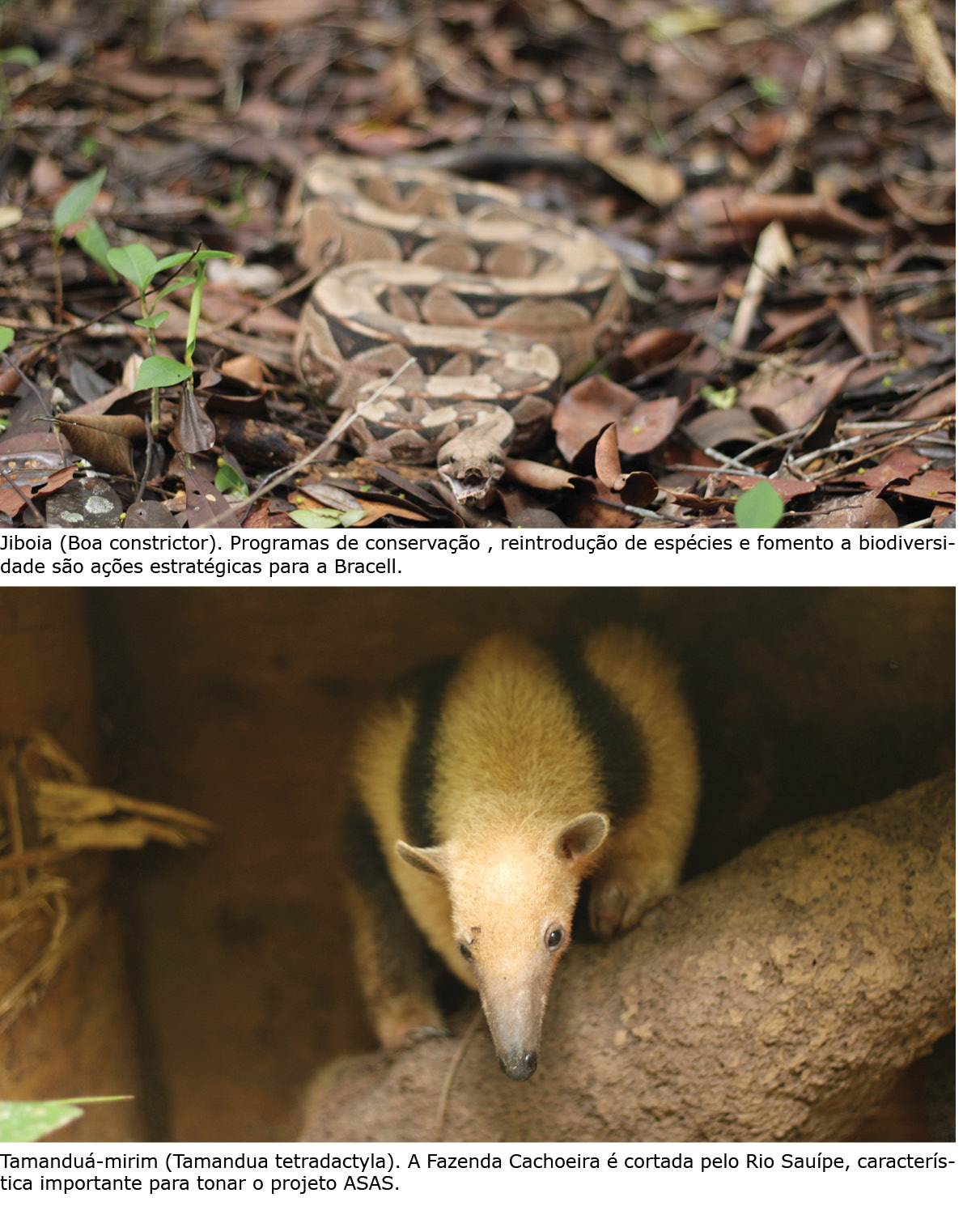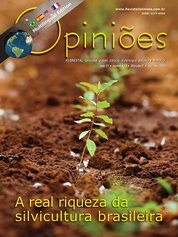Igor Estefane Lopes Macedo
Biólogo especialista em Meio Ambiente da Bracell
OpCP74
Da conservação à recuperação
Ao longo dos últimos anos, o setor florestal brasileiro conquistou uma notável visibilidade pela evolução de suas técnicas de manejo, incluindo relevantes investimentos em programas e projetos de conservação ambiental.
Rompendo as barreiras do atendimento básico de condicionantes ambientais e princípios das certificações, a Bracell Bahia vem construindo, há 10 anos, uma gama de programas ambientais para a manutenção e fomento à biodiversidade no litoral norte e agreste da Bahia. São nada menos do que oito programas ambientais, destinados à conservação da fauna, flora e dos recursos hídricos, incluindo iniciativas voltadas a promover a educação ambiental, especialmente, junto às comunidades vizinhas às unidades de conservação.
 Desde que foram criados, tais programas são continuamente aperfeiçoados com novas técnicas e tecnologias. Um movimento importante nesse sentido foi o Compromisso Um-para-Um, por meio do qual a Bracell se compromete a ajudar a conservar um hectare de floresta nativa para cada hectare plantado com eucalipto.
Desde que foram criados, tais programas são continuamente aperfeiçoados com novas técnicas e tecnologias. Um movimento importante nesse sentido foi o Compromisso Um-para-Um, por meio do qual a Bracell se compromete a ajudar a conservar um hectare de floresta nativa para cada hectare plantado com eucalipto.
Esse compromisso, que conta com as parcerias dos governos estaduais, envolve áreas próprias e públicas. A meta da empresa é que a equiparação seja alcançada até 2025 em todas as áreas de atuação da Bracell na Bahia, Mato Grosso do Sul e São Paulo. Outra medida importante é o lançamento do Bracell 2030, uma agenda estratégica de ESG com 14 novos compromissos e metas para os próximos sete anos, com pilares que envolvem ações pelo clima, desenvolvimento de paisagens sustentáveis e biodiversidade, crescimento sustentável e empoderamento de vidas.
Para ser mais específico, destaco o Programa de Monitoramentos da Biodiversidade para a Conservação da Fauna e Flora e o Programa de Regularização Ambiental, ambos iniciados em 2015/16, os quais assumiram um papel estratégico dentro da companhia. Por conta da importância que demonstraram ter, esses programas têm sido sucessivamente repaginados a fim de alcançar objetivos ainda mais ousados, de modo a contribuir, sempre mais e mais, para a melhor compreensão da relação entre o manejo florestal e a biodiversidade.
Monitorar a fauna e a flora tem como principal objetivo entender os impactos do manejo florestal na biodiversidade e sugerir ações mitigadoras para reduzi-los. Desde 2019, o programa segue o mesmo delineamento amostral, obtendo um histórico de resultados referentes às comunidades faunísticas e florísticas do litoral norte da Bahia. Esse delineamento abrange oito áreas distribuídas nos biomas Mata Atlântica, Caatinga e enclaves de Cerrados, sendo que quatro delas são consideradas de alto valor de conservação, seguindo critérios da certificação. Nelas, até o momento, foram registradas 641 espécies da fauna e 336 espécies da flora, sendo 44 ameaçadas.
Observando os dados ao longo dos 5 anos, aferimos que não há impactos significativos nas variações nas comunidades por conta da dinâmica da paisagem manejada. A elevada biodiversidade da região demonstra numa curva do coletor que a riqueza continua aumentando, agora com menor intensidade, mas com espécies raras e ameaçadas sendo somadas ao gráfico. A manutenção do avistamento das espécies ameaçadas, endêmicas e migratórias é um importante indicador de conservação quando comparada às atividades desenvolvidas pelo nosso manejo.
 Derivados do programa de monitoramento da biodiversidade, o Programa de Avistamento de Fauna e o cadastramento de Áreas de Solturas de Animais Silvestres (Asas) se tornaram importantes ferramentas para a manutenção da fauna local, educação ambiental, resgate e reintrodução de espécies nativas.
Derivados do programa de monitoramento da biodiversidade, o Programa de Avistamento de Fauna e o cadastramento de Áreas de Solturas de Animais Silvestres (Asas) se tornaram importantes ferramentas para a manutenção da fauna local, educação ambiental, resgate e reintrodução de espécies nativas.
Destinado a todos os colaboradores próprios e terceiros da empresa, o Programa de Avistamento traz para essas pessoas implicações da conservação da fauna silvestre para o seu dia a dia. Mais de 2 mil animais foram registrados desde o lançamento do programa e melhorias vêm sendo adotadas, como a elaboração de um formulário inteligente para a captação e análise rápidas de dados.
Por sua vez, o Asas é um programa voluntário junto ao órgão ambiental que cadastra áreas conservadas para a reintrodução de espécies. A primeira área cadastrada foi a RPPN Lontra (Itanagra/BA), em 2021, e em seguida as Fazendas Reunidas Marcanair (Jandaíra/BA) e Cachoeira (Entre Rios/BA). Juntas, até o momento, essas três áreas já acolheram e deram uma nova chance de sobrevivência a mais de 700 animais silvestres, entre aves, mamíferos e répteis.
Produto inicial das condicionantes ambientais para nossa operação, o Programa de Regularização Ambiental (PRA) abrange dois importantes vetores: a restauração ecológica e a erradicação de espécies exóticas. Pensado muito além da regulação legal, o
Rompendo as barreiras do atendimento básico de condicionantes ambientais e princípios das certificações, a Bracell Bahia vem construindo, há 10 anos, uma gama de programas ambientais para a manutenção e fomento à biodiversidade no litoral norte e agreste da Bahia. São nada menos do que oito programas ambientais, destinados à conservação da fauna, flora e dos recursos hídricos, incluindo iniciativas voltadas a promover a educação ambiental, especialmente, junto às comunidades vizinhas às unidades de conservação.
 Desde que foram criados, tais programas são continuamente aperfeiçoados com novas técnicas e tecnologias. Um movimento importante nesse sentido foi o Compromisso Um-para-Um, por meio do qual a Bracell se compromete a ajudar a conservar um hectare de floresta nativa para cada hectare plantado com eucalipto.
Desde que foram criados, tais programas são continuamente aperfeiçoados com novas técnicas e tecnologias. Um movimento importante nesse sentido foi o Compromisso Um-para-Um, por meio do qual a Bracell se compromete a ajudar a conservar um hectare de floresta nativa para cada hectare plantado com eucalipto.Esse compromisso, que conta com as parcerias dos governos estaduais, envolve áreas próprias e públicas. A meta da empresa é que a equiparação seja alcançada até 2025 em todas as áreas de atuação da Bracell na Bahia, Mato Grosso do Sul e São Paulo. Outra medida importante é o lançamento do Bracell 2030, uma agenda estratégica de ESG com 14 novos compromissos e metas para os próximos sete anos, com pilares que envolvem ações pelo clima, desenvolvimento de paisagens sustentáveis e biodiversidade, crescimento sustentável e empoderamento de vidas.
Para ser mais específico, destaco o Programa de Monitoramentos da Biodiversidade para a Conservação da Fauna e Flora e o Programa de Regularização Ambiental, ambos iniciados em 2015/16, os quais assumiram um papel estratégico dentro da companhia. Por conta da importância que demonstraram ter, esses programas têm sido sucessivamente repaginados a fim de alcançar objetivos ainda mais ousados, de modo a contribuir, sempre mais e mais, para a melhor compreensão da relação entre o manejo florestal e a biodiversidade.
Monitorar a fauna e a flora tem como principal objetivo entender os impactos do manejo florestal na biodiversidade e sugerir ações mitigadoras para reduzi-los. Desde 2019, o programa segue o mesmo delineamento amostral, obtendo um histórico de resultados referentes às comunidades faunísticas e florísticas do litoral norte da Bahia. Esse delineamento abrange oito áreas distribuídas nos biomas Mata Atlântica, Caatinga e enclaves de Cerrados, sendo que quatro delas são consideradas de alto valor de conservação, seguindo critérios da certificação. Nelas, até o momento, foram registradas 641 espécies da fauna e 336 espécies da flora, sendo 44 ameaçadas.
Observando os dados ao longo dos 5 anos, aferimos que não há impactos significativos nas variações nas comunidades por conta da dinâmica da paisagem manejada. A elevada biodiversidade da região demonstra numa curva do coletor que a riqueza continua aumentando, agora com menor intensidade, mas com espécies raras e ameaçadas sendo somadas ao gráfico. A manutenção do avistamento das espécies ameaçadas, endêmicas e migratórias é um importante indicador de conservação quando comparada às atividades desenvolvidas pelo nosso manejo.
 Derivados do programa de monitoramento da biodiversidade, o Programa de Avistamento de Fauna e o cadastramento de Áreas de Solturas de Animais Silvestres (Asas) se tornaram importantes ferramentas para a manutenção da fauna local, educação ambiental, resgate e reintrodução de espécies nativas.
Derivados do programa de monitoramento da biodiversidade, o Programa de Avistamento de Fauna e o cadastramento de Áreas de Solturas de Animais Silvestres (Asas) se tornaram importantes ferramentas para a manutenção da fauna local, educação ambiental, resgate e reintrodução de espécies nativas.Destinado a todos os colaboradores próprios e terceiros da empresa, o Programa de Avistamento traz para essas pessoas implicações da conservação da fauna silvestre para o seu dia a dia. Mais de 2 mil animais foram registrados desde o lançamento do programa e melhorias vêm sendo adotadas, como a elaboração de um formulário inteligente para a captação e análise rápidas de dados.
Por sua vez, o Asas é um programa voluntário junto ao órgão ambiental que cadastra áreas conservadas para a reintrodução de espécies. A primeira área cadastrada foi a RPPN Lontra (Itanagra/BA), em 2021, e em seguida as Fazendas Reunidas Marcanair (Jandaíra/BA) e Cachoeira (Entre Rios/BA). Juntas, até o momento, essas três áreas já acolheram e deram uma nova chance de sobrevivência a mais de 700 animais silvestres, entre aves, mamíferos e répteis.
Produto inicial das condicionantes ambientais para nossa operação, o Programa de Regularização Ambiental (PRA) abrange dois importantes vetores: a restauração ecológica e a erradicação de espécies exóticas. Pensado muito além da regulação legal, o
PRA vem recebendo amplas melhorias a partir de um raciocínio baseado na complexidade ecológica das florestas nativas.
Uma floresta restaurada precisa abordar uma rede complexa de interações fauna-flora com o ambiente. O delineamento utilizado favorece a dinâmica natural e seu potencial de resiliência. Nesse contexto, espécies funcionais para a alimentação, locais para refúgio, pousio e reprodução da fauna silvestre se tornam grandes aliados, enquanto a luta contra os fatores de degradação é sempre o maior desafio, juntamente com erosão, infestação de espécies exóticas, queimadas e invasão pelo gado.
Os aspectos avaliados no Programa de Restauração levaram a uma importante redução de custo por hectares, à qualidade superior das mudas e à escolha das espécies corretas, resultando em uma menor taxa de mortalidade. A erradicação de espécies exóticas com morte em pé, baseada na aplicação química local e controlada, reduziu os impactos na vegetação nativa e no custo quando, comparada ao corte raso dos indivíduos de pinus e eucalipto em meio à vegetação nativa. Até o momento, mais de 8.000 hectares foram restaurados graças aos esforços da Bracell Bahia, tendo ainda muitos desafios na manutenção dos fragmentos e controle dos fatores de degradação.
Apesar de se tratarem de iniciativas distintas, o Programa de Monitoramento e o Programa de Regularização Ambiental se complementam a todo momento. Por meio dos resultados das pesquisas de fauna e flora, é possível observar as espécies necessárias para o plantio de mudas e as interações a serem reconectadas no ambiente em restauração.
Conhecer bem o ambiente presente na área de influência nos proporciona um conhecimento robusto sobre as comunidades e sua teia de interconexões na busca para contribuir para a manutenção de um ambiente complexo, dinâmico, resiliente e sustentável.
Uma floresta restaurada precisa abordar uma rede complexa de interações fauna-flora com o ambiente. O delineamento utilizado favorece a dinâmica natural e seu potencial de resiliência. Nesse contexto, espécies funcionais para a alimentação, locais para refúgio, pousio e reprodução da fauna silvestre se tornam grandes aliados, enquanto a luta contra os fatores de degradação é sempre o maior desafio, juntamente com erosão, infestação de espécies exóticas, queimadas e invasão pelo gado.
Os aspectos avaliados no Programa de Restauração levaram a uma importante redução de custo por hectares, à qualidade superior das mudas e à escolha das espécies corretas, resultando em uma menor taxa de mortalidade. A erradicação de espécies exóticas com morte em pé, baseada na aplicação química local e controlada, reduziu os impactos na vegetação nativa e no custo quando, comparada ao corte raso dos indivíduos de pinus e eucalipto em meio à vegetação nativa. Até o momento, mais de 8.000 hectares foram restaurados graças aos esforços da Bracell Bahia, tendo ainda muitos desafios na manutenção dos fragmentos e controle dos fatores de degradação.
Apesar de se tratarem de iniciativas distintas, o Programa de Monitoramento e o Programa de Regularização Ambiental se complementam a todo momento. Por meio dos resultados das pesquisas de fauna e flora, é possível observar as espécies necessárias para o plantio de mudas e as interações a serem reconectadas no ambiente em restauração.
Conhecer bem o ambiente presente na área de influência nos proporciona um conhecimento robusto sobre as comunidades e sua teia de interconexões na busca para contribuir para a manutenção de um ambiente complexo, dinâmico, resiliente e sustentável.




